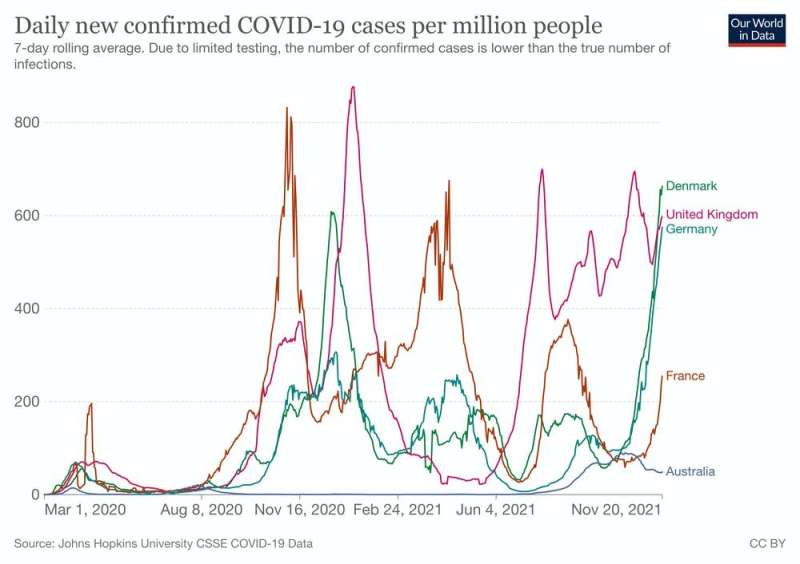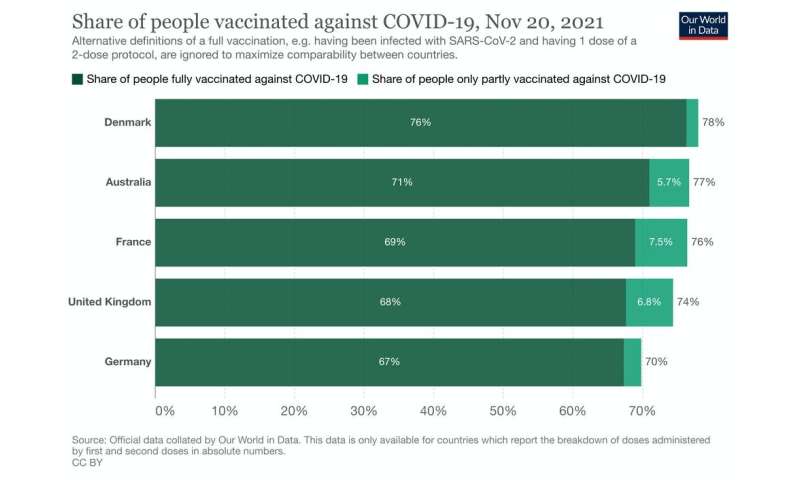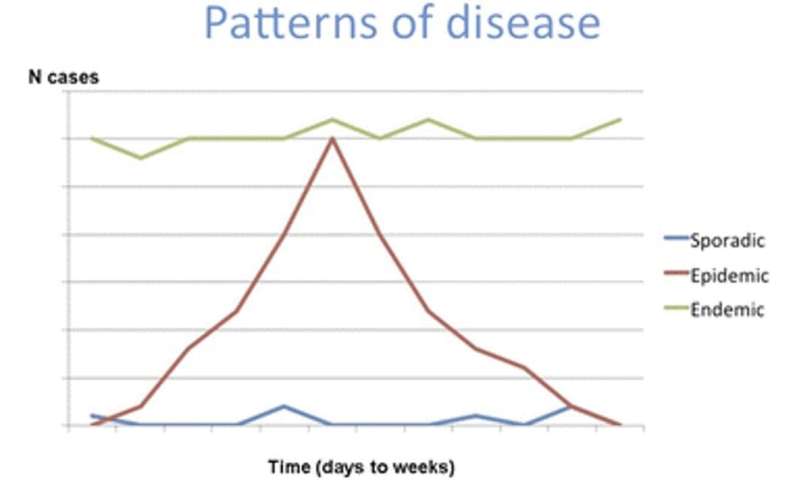
Europe is facing a fourth wave of COVID. As we watch on, it is reasonable to ask whether Australia will be confronted with the same fate.
Several factors will determine this: vaccination rates, high uptake of third dose boosters, vaccination of children and whether a comprehensive strategy of ventilation with vaccine-plus measures including masks, testing and tracing are used.
New OzSAGE modeling for NSW shows possible increasing cases from mid-December with a predicted peak in February 2022, despite high vaccination rates. OzSAGE warns if contact tracing is not maintained and children 5–11 remain unvaccinated, hospitals may be overwhelmed again. But if we vaccinate young kids and maintain high testing and tracing, the outlook is good.
If not for Delta
If the ancestral strains of the virus that dominated infections in 2020 were still in pole position, we would now have COVID well controlled in countries that achieved higher than 70% of the whole population vaccinated.
Unfortunately, just as the vaccines became available, new variants of concern began emerging. The currently dominant Delta variant raises the stakes because it is far more contagious and has some potential to escape the protection offered by vaccines. This means we need very high rates of vaccination across whole populations—probably over 90% of everyone vaccinated including younger children—to control the virus.
In addition, we need to start thinking about “fully vaccinated” being triple, not double, vaccinated.
Boosters are key
Patchy third dose booster policies in Europe may partially be to blame for the COVID surges we are seeing in countries there now.

Germany, for example, in October recommended boosters for people 70 years and over and certain risk groups. On November 18, it belatedly changed the recommendation to people aged 18 years and over in response to the large resurgence of COVID.
France, too, has been slow and restrictive in making boosters available for adults, with people over 50 eligible from this December. Likewise, Ireland only approved boosters for people 60 years and over at the end of October.
The evidence is clear that boosters are needed. So, on the background of inadequate vaccination rates ranging from 64% in Austria to 76% in Denmark, a slow and restrictive approach to boosters, together with abandoning other measures such as masks, has left many European countries vulnerable.
Austria, with one of the lowest vaccination rates, has one of the highest rates of COVID, prompting it to be the first European country to mandate vaccines.
Much of the fourth wave is also being driven by transmission in children. The EU has been slow to approve vaccines for younger children, prompting Austria to commence vaccinating children without EU approval.
Too much reliance on vaccines?
The fourth wave follows the relaxation of COVID restrictions like masks, density limits, testing and tracing; and failure to address safe indoor air.
The Delta virus is a tenacious beast, and the vaccine alone is not enough to tame it. Country after country has shown this, including Denmark, which ceased all restrictions, including masks in September and is now facing a large surge in cases despite relatively high vaccination rates.
The prospect of a fourth wave also depends on the epidemiology of SARS-CoV-2. There is a high probability new variants will emerge that will challenge us further, either because they are even more contagious or more vaccine-resistant.
That said, we have seen spectacular advances in science, with vaccines produced in less than a year. There are many more second generation vaccines and matched boosters in the pipeline, and promising new antivirals for early treatment. So our ability to fight this virus will keep improving.

What about Australia then?
So will Australia also face a fourth wave? Yes, it’s likely because SARS-CoV-2 is an epidemic infection. It will continue to cause the waxing and waning cycles of true epidemic infections just like smallpox did for thousands of years, and like measles still does. However, it’s possible we can achieve elimination of COVID just as we have with measles, and only see small outbreaks.
If we’re successful, outbreaks may still occur—but they will not become sustained or uncontrollable. Here’s what Australia can learn from Europe and other countries:
- firstly, we need to aim for at least 90% of the whole population vaccinated—this should be done equitably for all states and territories, for remote and regional areas and for all subgroups including children
- we need to be agile and responsive to evidence, including the need for subsequent boosters. If a new vaccine or Delta-matched booster comes along that improves protection, we need to add that to the tool box rapidly
- childcare and schools are fast becoming the new frontier of COVID. We must ensure safe indoor air, masks and vaccination for younger children by the time students return from summer holidays in 2022
- vaccines alone are not enough, so let’s not be like Denmark and embark on magical thinking. We need to address safe indoor air and have a vaccine-plus strategy. That means masks in indoor settings, maintaining high testing and tracing levels, protecting younger kids until they are eligible for vaccination and ensuring high uptake of boosters.
If we acknowledge the airborne transmission of COVID and adopt effective ways of preventing this virus, we can defeat it.
But that requires a layered, comprehensive strategy of ventilation, vaccine-plus measures and the ability to move quickly with evidence as it becomes available.
Source: Read Full Article